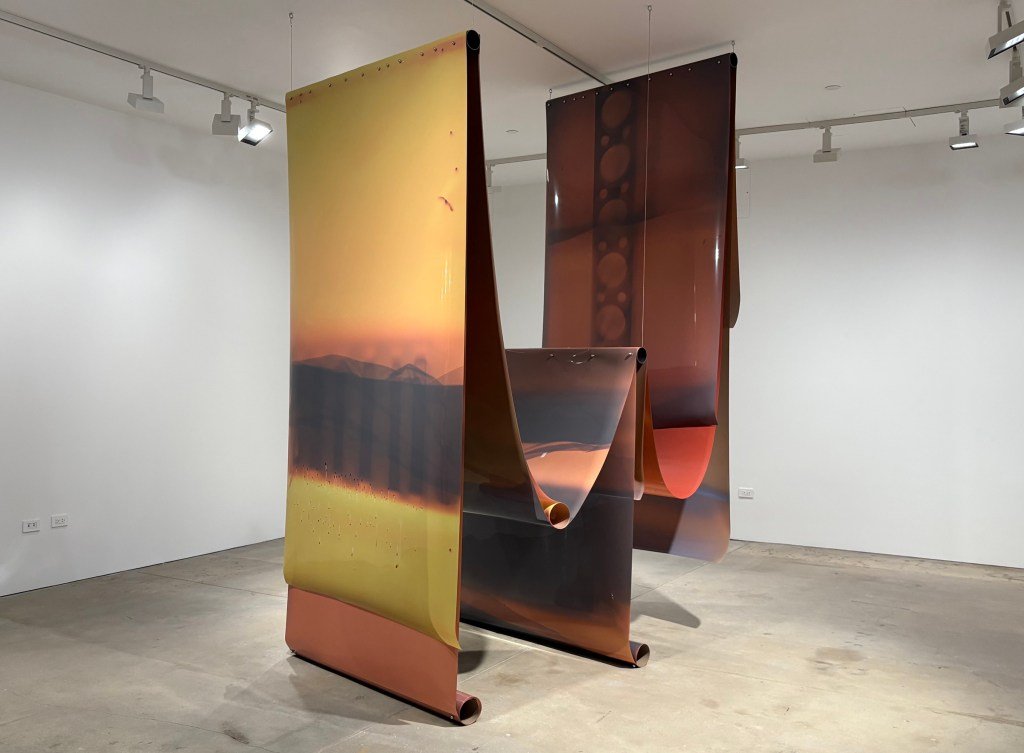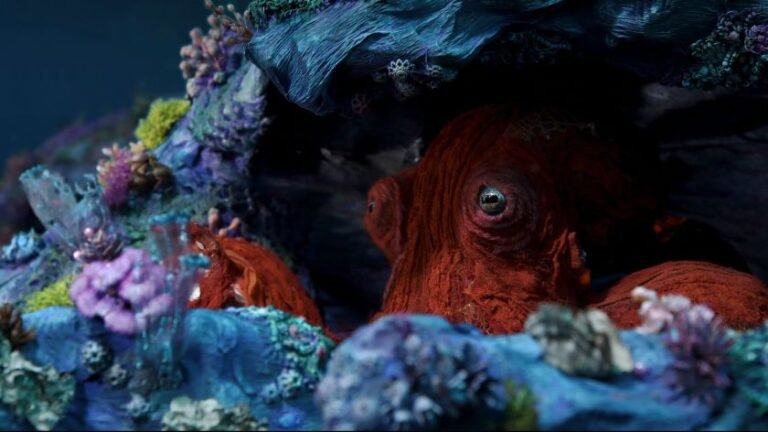

We are greeted by what appears to be a pair of metal drums suspended from the ceiling upon entering Lotus L. Kang’s exhibition Already at 52 Walker, curated by Ebony L. Haynes. Their musical potential, quieted for now, is instead visualized through sharp metal forms tumbling vertically downward. A closer look reveals that these quasi-chimes — they have functioned as such in previous iterations — are cast into the shape of anchovies, their slender bodies riddled with holes before being strung together as casually as flower chains. And the steel drum is not a drum at all, but a kitchen steamer. Is this a scene of ceremonial death, of objects methodically leeched of their function? Or a firmament of collective possibility — the music to be made, the dish to be shared?
Kang’s work is characterized by poetic abstractions that clarify into discernible everyday objects. Their magic is drawn out by the artist’s meticulous rearrangements, rewarding only the patient observer. Together the sculptures, entitled “Tract XX (You are already II)” and “Tract XIX (You are already)” (both 2025), are in some ways a portrait of the Canadian-born artist’s diasporic life as a “fish out of water,” and provides a helpful framework to connect with the remainder of the works in the exhibition.

Anchoring opposing sides of the gallery are two identical steel greenhouse structures titled “Receiver Transmitter” (2025), which form the shape of a bisected tunnel. They provide a glimpse into Kang’s process of tanning large lengths of film for other nearby works, such as those in the Molt series (2024–25), whose patterns are shaped by the bright light within the greenhouse. In the gallery, they have been drained of warmth and sunlight; nothing grows inside. In fact, they hold the inverse of abundance: Styrofoam fruit nets still pregnant with the void of what they once held, dried lotus tubers, lonely liquor bottles, and porcelain bird figurines with mouths agape. Defying expectations, the arched architecture instead feels like a mechanical throat, as suggested by the work’s title, provoking a shudder when we are within its cold and silent vice.
Draped on industrial cables behind this installation are dramatic scrolls of film that continue to change slowly as they are exposed to light. In “Molt,” Kang relinquishes control to the elements while maintaining immaculate precision in composition. The film’s gradients, ranging from a sooty brown to luminous peach, evoke a metropolitan skyline at sundown or a skeletal X-ray scan. Like the spotless mirrors that cover the surfaces of neighboring sculptures, Kang’s mercurial photo negatives invite viewers’ projections to complete the work.

Philosopher Byung-Chul Han identifies this “molting” sensibility in his observations about the Chinese concept of shanzhai, in which a piece of art is fluid and ever-changing, “like a living creature that grows, sheds its skin, and transforms himself.” It is a philosophy at once at odds with Western art historical traditions of static and discrete objects, as well as the commercial interests of coveting or collecting. In this way, Kang fits neatly into Haynes’s ongoing program, which was established as a project by and for people of color, but most importantly, embraces opacity as refuge for the wounded. This perspective feels especially important when figuration by oppressed minorities as a form of symbolic repair has become both state-sanctioned and subsumed by the market — a combination that is politically anesthetized, “noxious to no one,” as Jodi Melamet excellently puts it. At a time when a militarized state is actively paralyzing liberation movements with violence and efficiency, Already provokes the question: How might we survive through these brutal constraints, this enforced stasis that is called being alive?
Kang challenges the expectation that continual creation and a predetermined morbid fate are contradictory. Songless birds, deodorized fish, under- or over-developed film — these subjectless voids each dramatize the tragedy of what defeat might look like. And yet, even in extinguished life, there is life. Kang evaluates what new possibilities and temporalities can emerge from engaging in processes alien or forbidden, such as exposing film to sunlight. Even objects fossilized into stillness are plotting their next motion — contained “spirits” and animals threatening personhood — defying their categorization.

Descending the gallery stairs, one passes through a dense forest of industrial bookshelves — the gallery’s library collection — in order to view Kang’s magnum opus, “Azaleas II” (2025). The work spins transparent film around a metal frame, projecting ribbons of subdued color around the room’s perimeter. Echoing the dipoles of earlier work (skeletal and architectural, illuminated but dark, punctured but womb-like), it also contains a page from Autobiography of Death (2018) by Kim Hyesoon, which supplies the show’s title, according to the press release. The poem has not yet been translated from Korean, defying easy interpretive meaning in this context for those unfamiliar with the language, just as the 35mm film that rotates around the dryer’s axis divulges no legible meaning, revealing upon close inspection only the blossoms of purple orchids. To desire understanding, to ask what it all means, is to be invited to dive into the archives, as Kang clearly has done through rigorous historical and material research.
Kang joins these voices from the past in forming a bulwark against the rising tides of political pessimism by moving the goal post from an agreeable ending to the necessity of process, in which we cling together even if collectively spiraling around the same axis in perpetuity. If the pursuit of freedom is a doom scroll, a spiral that loops back into itself, what happens if we realized we’ve already arrived? That part of feeling free is braving the will to struggle for it, even knowing that looping back around to the beginning is inevitable? This is what keeps me returning, again and again, to experience Kang’s work as if it were the first time.




Lotus L. Kang: Already continues at 52 Walker (52 Walker Street, Tribeca, Manhattan) through June 7. The exhibition was curated by Ebony L. Haynes.


